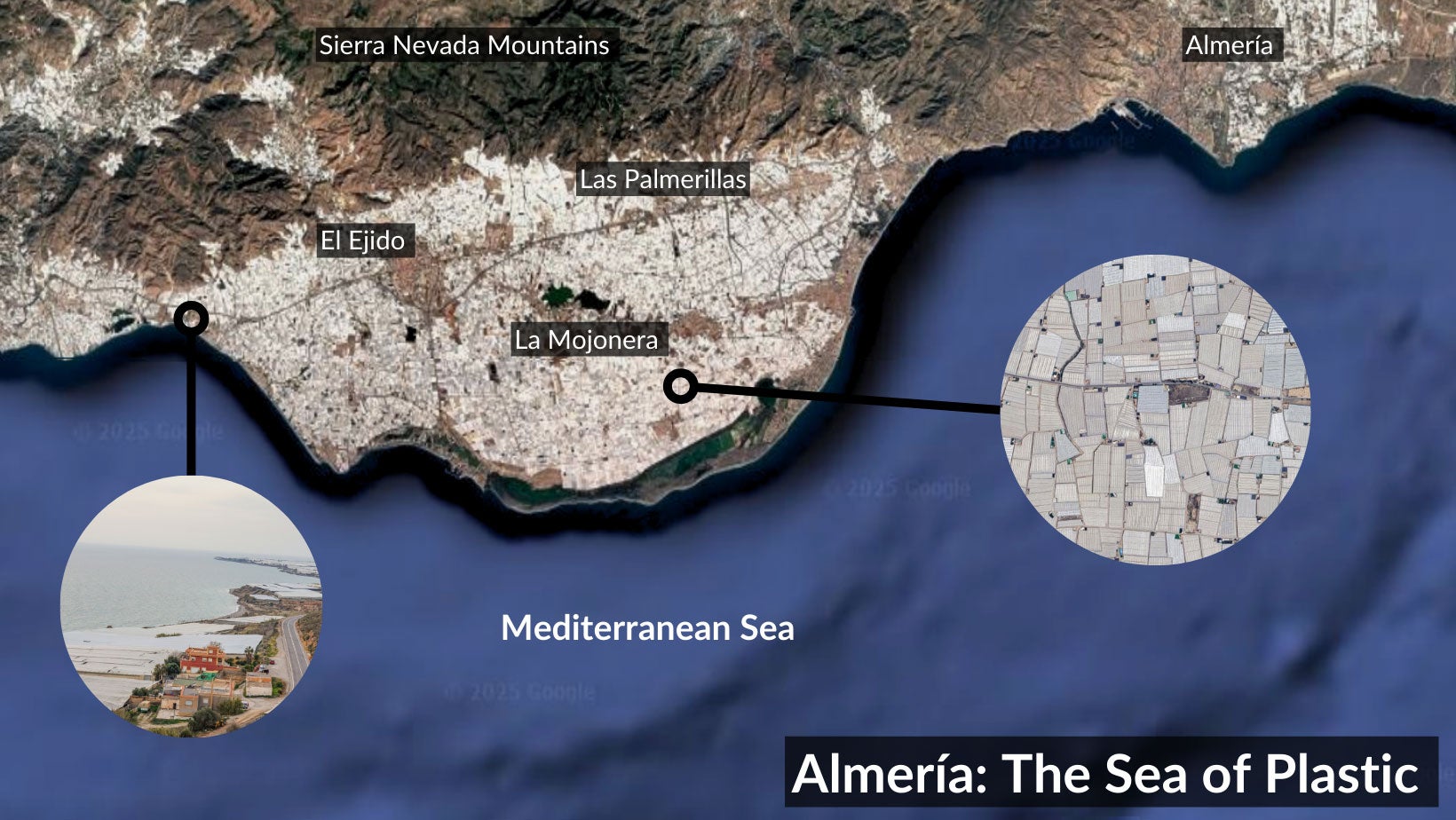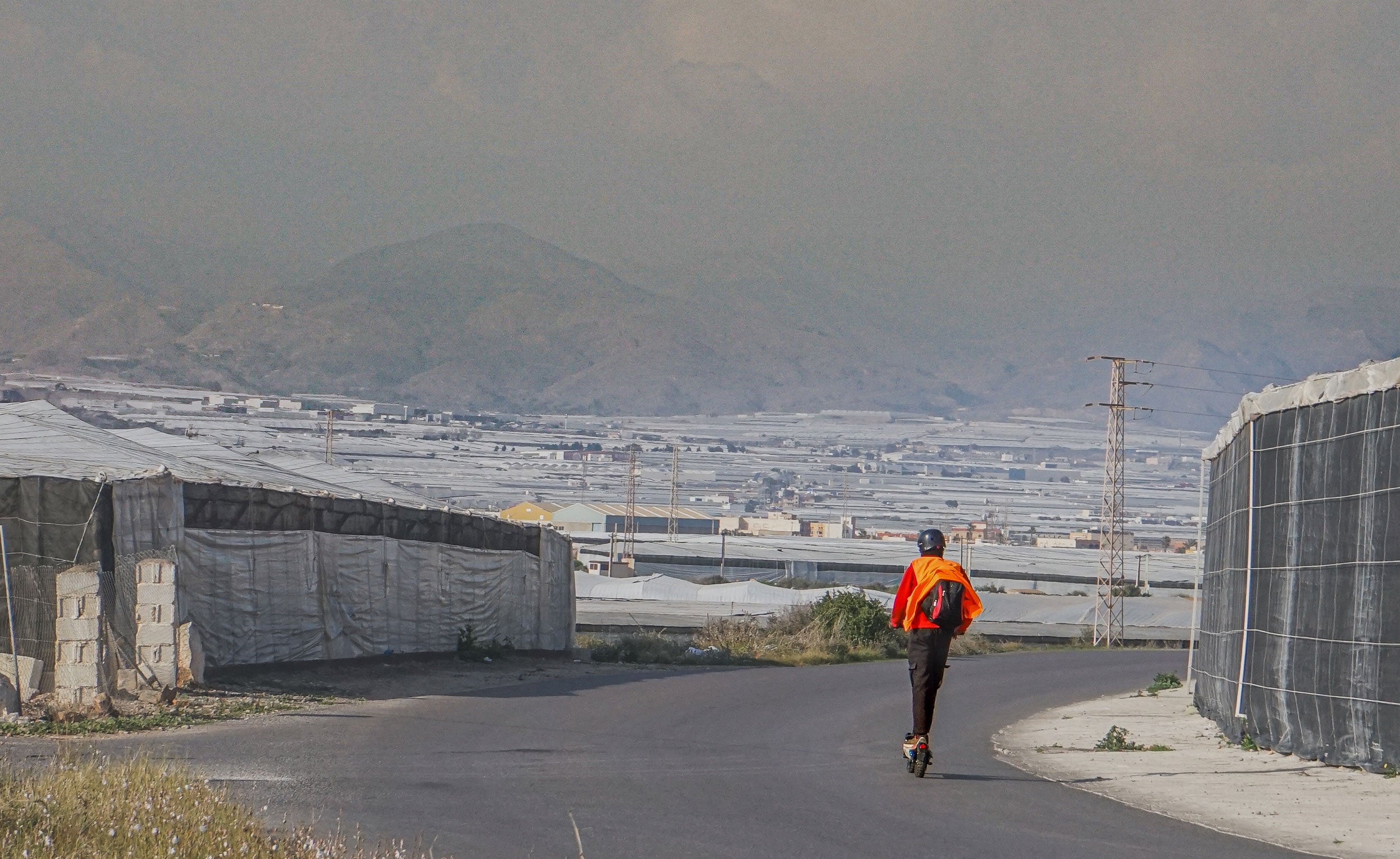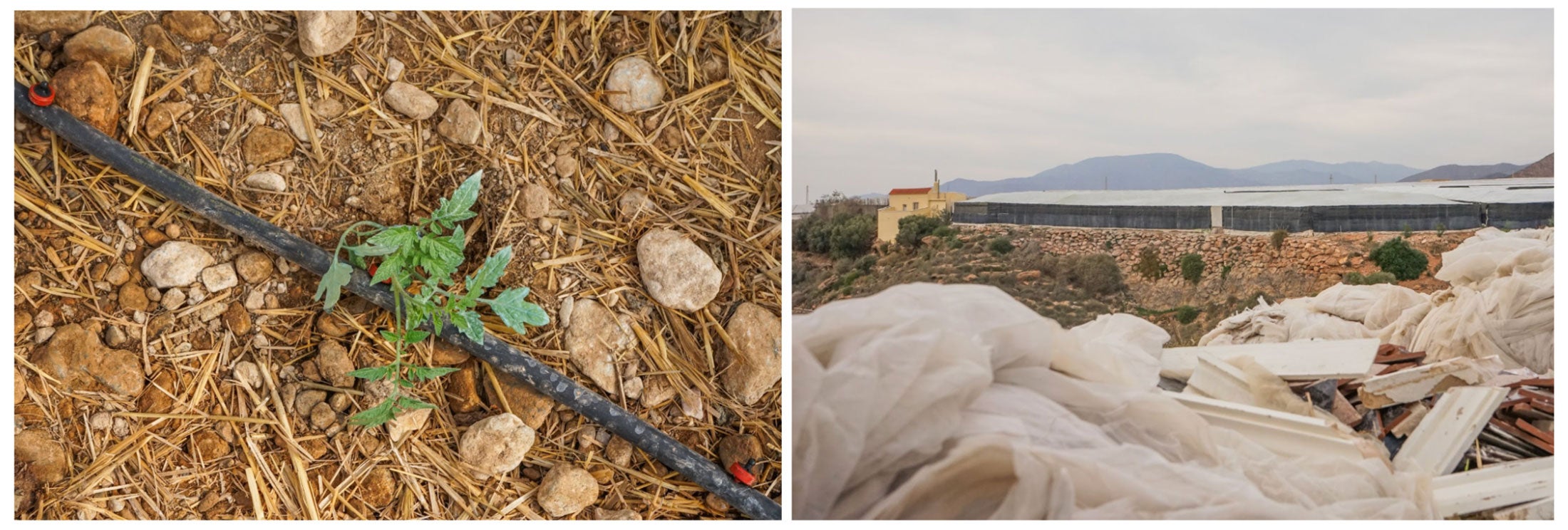ALMERÍA, Andalusia, Spain — Across 60 miles of coastline, one region produces more vegetables with greenhouses than any other climate in the world.
On a map, 33,000 hectares appear as a vast white expanse under the Spanish sun, with roads dividing the plots of land per farmer. On the ground, a maze of greenhouses, logistics hubs, and workers on scooters supply almost 24 percent of Europe’s vegetables.
In the arid, subtropical climate of Almería, a city in southern Andalusia, Spain, this intensive growing region operates nearly year-round without the need for heated greenhouses or advanced technology. The coastline is known as Mar de Plástico, or Sea of Plastic. Only drip irrigation, stakeholding poles, and a clear polythene plastic enclose the tomato, cucumber, and pepper greenhouses.
Although climate change is the often reason intensive farming systems are criticized in the public’s eyes, it is also why they continue to expand and secure their place in the market. As winter temperatures rise and annual rainfall decreases, this region of Spain is experiencing an extended growing season.
Those who farm, market, and research the area see intensive agriculture as highly organized and efficient. Yet, it comes with trade-offs: environmental risks from plastic waste and a humanitarian crisis for workers, challenging its social and environmental sustainability.

It is one of many intensive farming hubs feeding its continent. Elsewhere, the Netherlands cultivates horticulture goods in over 10,000 hectares acres of glasshouses. The western United States hosts the world’s largest cattle feedlots. Japan leads in offshore aquaculture. Antalya, Turkey, and parts of China mirror Almería’s sea of plastic, leveraging ideal climates for low-input farming.
So, how did a Mediterranean mountain slope leverage ideal climates for low-input farming and become the solarization farming capital of the world?
Agribusiness thrives with growth
Nearly 13,000 farmers cultivate 33,000 hectares (81,500 acres) in the Almería region, each working 1 to 1.4 hectare plots — primarily family farms organized into cooperatives. The region reflects the structure of European agriculture, with many small producers managing fragmented landholdings.
Farmers grow tomatoes, cucumbers, eggplant (aka aubergine), peppers, and some melons, totaling 2.7 million tons annually, much of which is exported to the United Kingdom, Germany, and France.
With greenhouses clustered tightly together, businesses flock to Almería for easy access to farmers. They rely on thousands of crop consultants, including cooperatives, biological input companies, and fertilizer providers. These advisors visit farms weekly to scout for pests, monitor plant health, and guide production — creating a dense, collaborative network of knowledge exchange.
While growers make their own decisions, the advisory system that surrounds them creates a kind of tunnel vision, streamlining efficiency gains at an astonishing pace. Year after year, growers fine-tune their operations, each managing one piece of the complex greenhouse puzzle in southern Spain.
“I have been a farmer for many years, and I think each time [year] it is improving quite a bit with new varieties, in flavors, qualities, and consistency, ” said Jose Ortega, a grower with the EjidoMar cooperative. He said they produce high-quality crops for Europe and are proud to do so. Their systems, he noted, are “more managed, better regulated.”
As logistics manager Jose Miguel Lopez Castillo explained, “It is a tradition of many people, leaving their skin day after day at work in the sacrifice of always trying the best agriculture possible.”
The farmers focused on production, while their cooperatives looked ahead, planned for the future, marketed products, and made a name for southern Spain produce.
This intensive farming system has led to the widespread adoption of beneficial insects in integrated pest management (IPM) and helped prevent catastrophic cucumber diseases. Initially, farmers never intended to scale up or farm so densely, but the region evolved rapidly.
“When something works and they’re convinced, they adopt it quickly,” said Juan José Magán Cañadas, director of plant technology research at Estación Experimental Cajamar, a cooperative research station funded by the agriculture bank, Cajamar Caja Rural.
Almeria is a prime example of economies of scale. Many farmers shared knowledge, found a market opportunity, and became an agribusiness masterpiece.

For the past 30 years, extension advisors have emphasized cost efficiency, a message producers took seriously. Historically, Almería was one of Spain’s poorest provinces, relying on subsistence farming.
“The region’s expansion wasn’t driven by the need for more land but by cost reduction, which spurred the growth of more producers — a common misconception, worsened by corporations, not local farmers,” said Lena Schaller, a senior researcher at the Institute of Agricultural and Forestry Economics at BOKU Vienna, Austria.
“If crop prices fall or soil conditions deteriorate, farmers face two choices under the economic principle of economies of scale: intensification or abandonment,” Schaller said.
She explained that cost efficiency in vegetable production often means “larger units and lower labor costs.” While producers may not always be the ones expanding, cooperatives and logistics companies benefit from these economies of scale.
In the 1970s, grape production and cattle dominated the region, until floods washed away the landscape, allowing producers to start anew, with government aid.
Farmers pivoted to tomatoes as land remained cheap, $150 per hectare (a hectare is about 2.5 acres), though greenhouse infrastructure cost $6,000 per hectare. To support small farmers’ need for financing, banks and cooperatives such as Cajamar Caja Rural became essential.
“Agricultural finance and climate change also accelerated intensive farming in this region of Spain,” Cañadas said.
Beyond economic pressures, natural conditions of intensive farming which include climate, soil, topography, and groundwater availability, helped drive greenhouse expansion in Almería.
Growing variables that require no change
The Cajamar Experiment Station helps growers fine-tune small variables while maintaining resource efficiency as costs rise. Acting as a real-world trial center, it replicates exact growing conditions without disrupting production.
Researchers at Cajamar focus on simple growing variables, even when sustainability trends push for alternatives. Low-tech solutions often prove more practical, as seen in Almería’s steady technological evolution — drip irrigation introduced in 1975 and biological pest control fully adopted in peppers by 2008.

The region’s parral-style greenhouses — which stand 18 feet tall and are designed with weatherproofing to reduce interior humidity on rainy days and facilitating climate control — have also seen little change. Designed for labor efficiency, they allow workers to harvest without ladders and use arch systems for tomatoes and peppers, avoiding labor-intensive trellising like in Dutch greenhouses.
While Northern Europe and the Netherlands push high-tech controlled-environment systems, Almería’s growers prioritize low tech, high yielding production. Glass, for example, fails to diffuse radiation as effectively as the region’s signature clear plastic covers.
“When we did the trial, it was interesting, but with labor costs rising, it won’t not be profitable,” Cañadas said.
Almería serves as a growing reference for the Mediterranean as its climate, winter production, and cultivation methods set regional standards. Cañadas explains that consumers’ expectations keep rising. “They’ve tasted tomatoes from around the world and know what quality should be,” he said.
Despite striving for premium produce, Almería faces pressing input challenges.
Water access is a prerequisite for farming. Rainfall averages less than 8 inches per year, well below the 24 inches needed, forcing reliance on wells, reservoirs, or desalination — an expensive but growing solution. “The most expensive water is the water that doesn’t exist,” one grower remarked.
Polythene plastics define Almería’s greenhouses, yet also pose a major environmental challenge. Discarded plastic litters roads, fields, and even the sea.
Though 90 percent of greenhouses use plastic, they are integral to the region’s bioeconomy. Thicker greenhouse plastic is recycled locally, while thin mulch plastic remains a costly disposal burden for growers. The region is exploring circular economy solutions, including microorganisms to recycle agricultural waste and renewable energy integration.
Vicasol, a cooperative of 950 farmers, said in response to environmental concerns, “We acknowledge and accept the consequences of our actions and we are committed to manage their impacts through the innovation and improvement of our social and natural environment.”
Despite reliance on low-tech innovation, investment in seed development and research remains high. But as many in the region noted, “Agriculture can pay for it.”
Due to Almería’s agricultural wealth, Spain’s farmers are among the most politically powerful in the world.

The missing piece of sustainability
Growers worry about risk — in their disease management, soil health, and profitability. However, the culture of viewing workers’ rights through housing, fair treatment, and wages is not a risk considered by the majority intermediary labor companies, and even farmers who hire them indirectly.
Agricultural work always carries risks, but especially in a region where 120,000 laborers work under often difficult conditions. Almería’s near-year-round production requires a constant labor force, unlike neighboring Huelva, a berry-producing region that depends on seasonal labor.
The sustainability of Almería’s agricultural labor force remains in question. Workers across Europe are often recruited through intermediaries and informal negotiations.
Carlos Ruiz Ramirez works directly with farm workers in Spain through his research role with Oxfam Europe, a global organization that fights inequities in agriculture.
“The people who usually come here often don’t know how to read or write, and they don’t speak Spanish. So usually, they just accept whatever conditions they are given.” An OxFam report claims that around one in four workers in the agriculture sector of Europe are migrants.
The workers come from within Europe, particularly Eastern European countries like Romania and Bulgaria, for seasonal work. Others arrive through government immigration agreements with countries like Morocco. Additionally, there is an increasing amount of labor migration from African countries like Senegal and Malawi.
The conditions include slums, or informal housing settlements, and an increasing number of workers immigrating in search for work without formal contracts that would provide housing support and government oversight.
“The companies and horticulture sector are happy they are coming,” Carlos said. “However, the public discourse often denies the reality of living conditions and the humanitarian crisis.”
Katie Hooper, senior policy analyst with the Migration Policy Institute’s International Program, notes that “countries are recruiting workers from further and further afield.”
Historically, labor has come from Poland, Romania, and Bulgaria. However, as wages rise and economic opportunities grow in these countries, fewer workers are available for agricultural jobs in Spain.
“We don’t have very good data on workers’ skill profiles or how they evolve over time, and that’s a challenge,” Hooper said.
The industry is now increasingly looking beyond Europe for labor solutions, in addition to solving the welfare issues on fruit and vegetable operations at the farmgate.
Jake Zajkowski is a freelance agriculture journalist covering farm policy, global food systems and the rural Midwest. Raised on vegetable farms in northern Ohio, he now studies at Cornell University.



